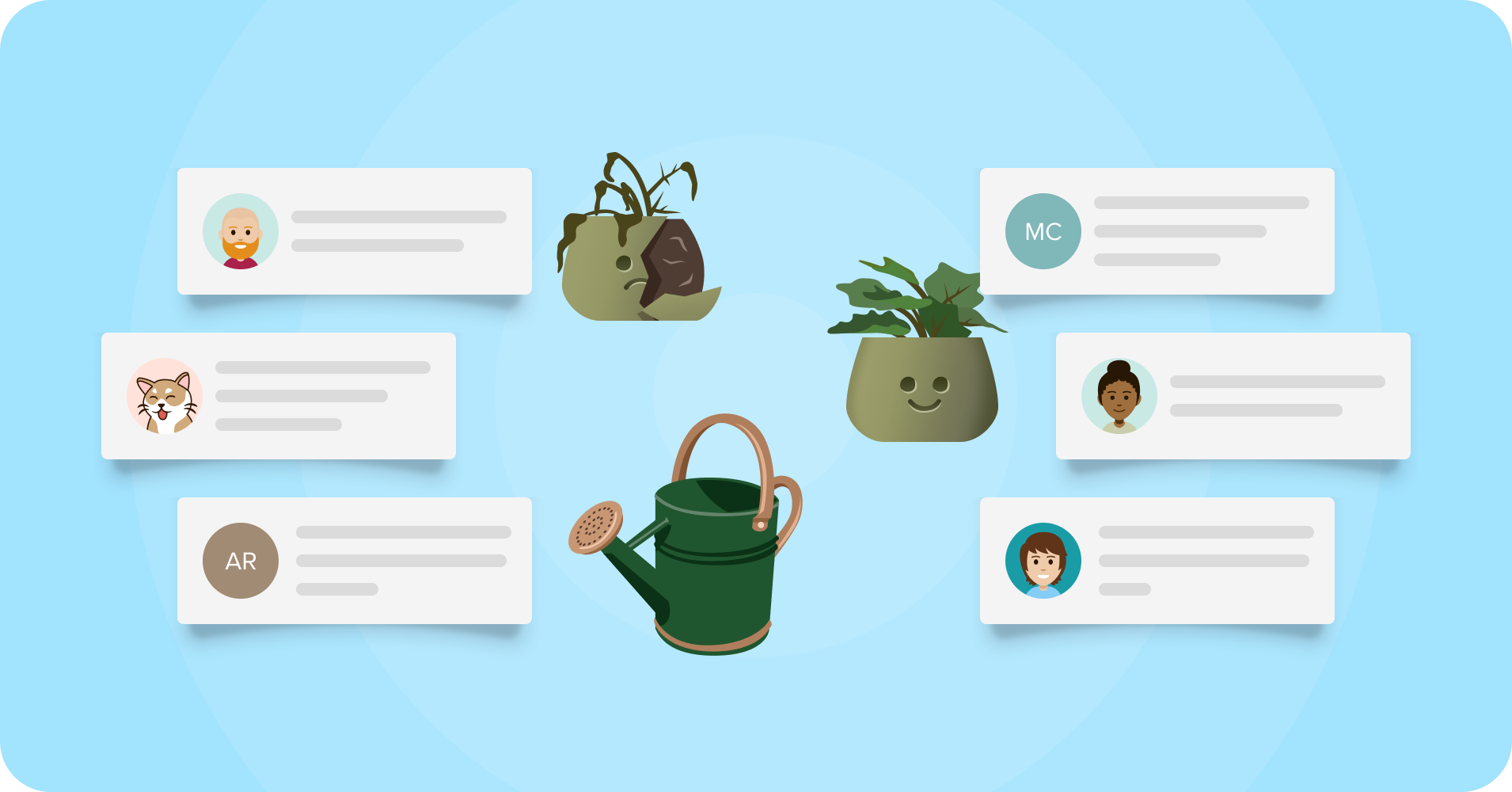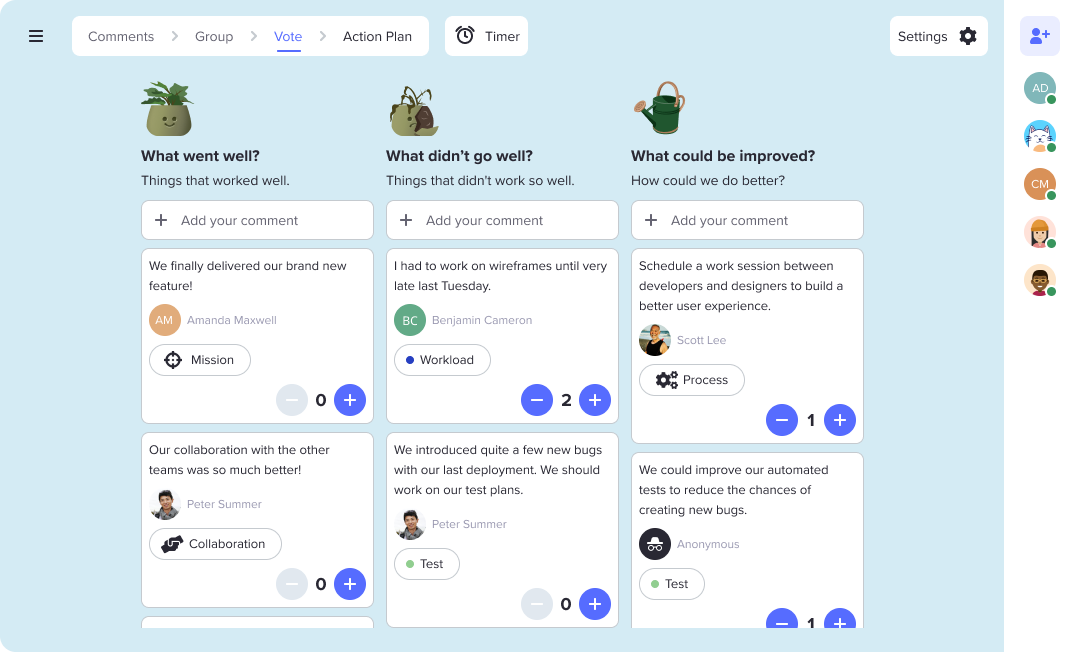The What Went Well Retrospective Template

What is the What Went Well retrospective template?
What worked well? What didn't go so well? How could we improve in our next Sprint? These are three existential questions that thousands of Agile teams raise at the end of each Sprint - or work cycle.
Before going any further, let's define what a retrospective should be.
“A retrospective is a chance for a team to reflect and learn from the past within a structured meeting. The main aim is to inspect the situation and adapt to the reality.”
- Aino Vonge Corry, Retrospectives Antipatterns
Simply put, the purpose of retrospectives is to help teams improve continuously.
Traditionally, a retrospective would allow a team to reflect collectively on three key questions: "What went well?", "What didn't go so well?", "How could we improve?".
Good news, this is exactly what the What Went Well retrospective template delivers. 👌

How does the What Went Well retrospective format work?
What Went Well is a simple but straight-to-the-point retrospective format. This activity works for all your Sprint retrospectives, project post-mortems, or team retrospectives. It is also a valuable tool for personal introspection.
Given the simplicity of this format, you can directly begin your meeting by presenting each of the 3 retrospective questions below.

Ask each team member to suggest one idea per note (or comment). In this category, you will discuss any practice, process, or behavior that helped the team move toward success during the Sprint.
You can also take the time to highlight actions or the attitude of certain members who contributed to the team's success.
For example:
Our testing processes really allowed us to identify and correct bugs before deployment.
Our weekly meetings with Team Marketing helped to align our respective needs.
Andy, thanks for offering group coding sessions on Friday afternoons!

This section records all the things that didn't work as expected. The goal is to speak transparently about the processes, practices, or behaviors we would like to correct.
To maintain a high level of psychological safety, remind the participants that it is not about settling scores or pointing the finger at people. It is all about stating facts. Use the Prime Directive to make the exercise more effective.
For example :
We did not properly anticipate the workload to support the Marketing team.
I was slowed down by a lack of information in my Jira tasks.
Some requests to modify the scope of work arrived too late, at the end of the Sprint.

Here we are! This column is your sandbox to develop new ideas or areas for improvement. The golden rule is to find action items that the team can complete.
Here are other examples to better understand this section:
Better estimate tasks to help the Marketing team for the next Sprint.
Review task descriptions and requirements before assigning them.
Involve stakeholders earlier in our ideation process.
Once this retrospective format has been mastered, you will be able to explore our Agile retrospective ideas and try new activities!.
Why is the What Went Well retrospective template so effective?
We highly recommend What Went Well for newly formed teams, as well as teams who want to discover the potential of retrospectives and host one for the first time.
The simplicity of this activity also makes it the perfect model for a first online retrospective. Remember that using and mastering a new tool can sometimes take time (e.g., the tool may be lacking in its intuitive aspect, or some people may be reluctant to the proposed change). This is why choosing a very simple activity like What Went Well can maximize your chances of offering your team a caring and productive retrospective.
Before you dive into your next retrospective, here's a piece of advice: take the time to go through each comment posted by your team members. Let the discussions flow and then collectively determine action items - on which the team commits to start improving quickly.
Indeed, even though What Went Well looks super simple, you need to give people time to express themselves.
Icebreaker question examples for the Glad Sad Mad retrospective template
We always recommend starting a retrospective with a check-in session and/or an icebreaker activity.
When beginning your retrospective, spend a few minutes breaking the ice with your team members - you will benefit from their full attention, and your retrospective will only be better!
With Neatro, we invented the Question Game: an icebreaker of more than 400 questions grouped under 4 themes.
Questions on the theme “Getting to know yourself”:
What is your favorite card game?
Is there any podcast you'd like to recommend?
What is your idea of a perfect vacation?
What sport would you compete in if you were in the Olympics?
What is the most unusual place you have visited?
Questions for “Having fun together”:
Tonight, we're all going for karaoke. Which song will you sing?
Hey, Chef! What is the best dish you can cook?
How would you say your name if you were an alien?
What fictional place would you like to visit? Tell us why.
Share your favorite 'dad joke' or pun.
Questions for “Improving team spirit”:
What are the best ingredients of a successful retrospective?
Describe your ideal work day in one sentence.
What's your best tip to stay zen all day long?
What is one thing you value about your team?
What's the most memorable gift you've ever received at work?
Finally, the theme of “Questions for reflection”:
If you could travel back in time, where/when would you go and why?
If you had the power to teleport yourself, where would you go right now?
Who is someone you admire in your life and why?
What major issue do you believe technology will solve soon?
If you could remain a certain age indefinitely, which age would you choose?
Want more? Check out our guide to the top 100 icebreaker questions or the "2 Truths and 1 Lie" icebreaker activity.
One last thing! Claim your 30-day free trial to use the What Went Well retrospective template and break the ice with the Question Game in Neatro.
Enjoy your retrospective!




